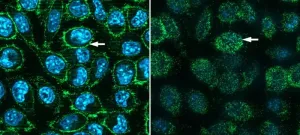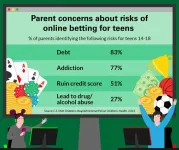(Press-News.org) Bad to the Bone: UMass Amherst Engineer Aims to Prevent Fractures in Cancer Patients
National Cancer Institute funds research to assess if the treatment of cancer metastasis in patients is as damaging as the disease
AMHERST, Mass. – For some patients whose cancer has spread to their bones, the ensuing treatment can be more physically damaging than the original disease, leading to increased bone loss and fracture. Stacyann Bailey, assistant professor of biomedical engineering at the University of Massachusetts Amherst, has received a two-year grant from the National Cancer Institute to study the complex relationship between drugs used to treat metastatic cancer and the development of bone damage.
“While there is much attention on early detection and diagnosis, our patients are not dying from primary cancer. They’re really dying from metastasis, whether it’s to the lung, the brain, or the bone, which is the subject of my research,” says Bailey. “Breast cancer, prostate cancer, lung cancer, kidney cancer—those are the top primary cancer types that eventually break off from that primary site and make its way into the bone.”
Bailey’s new $392,617 grant will allow her to focus on this bone damage in late-stage cancer patients and determine whether immune checkpoint inhibitor cancer treatments can decimate bone.
“When you give a patient an immune checkpoint inhibitor, it does a really good job at killing the tumor cells, which is what we want,” she says. “However, for some unknown reason, which is a goal of the grant, it seems like activating the immune cells—or overactivating the immune cells—now has bad effects on the bone.”
Bailey suspects it’s because immune cells have their own relationship with bone cells. “People don’t understand how central your bone is to your immune system,” she says. “Your immune cells are housed there. Immune cells regulate bone formation as well as bone resorption [the process by which the body breaks down bone to release stored minerals]. I can think of every other system that we can link bone to—reproductive, endocrine, urinary, digestive.”
Fracture is already a significant concern for patients with metastatic bone disease. “When the cancer cells go to bone, there’s already bone loss, there’s already risk of fracture,” Bailey explains. Up to 50% of patients with metastatic bone disease develop fractures depending on the primary tumor type and bone site, and immune checkpoint inhibitor therapy appears to compound the issue.
“My long-term, big picture will be: how can we prevent fractures from happening?” she says. “Because when we do that, then patients can live longer and they can have a better quality of life,” like avoiding multiple surgeries and prolonged bed rest while managing other comorbidities, such as diabetes, osteoporosis and Alzheimer’s disease, that also independently affect bone health, she adds.
This grant will allow Bailey to explore several facets of this condition. The first is determining if the immune checkpoint inhibitors are to blame for the bone damage, because that mechanism is poorly understood: “If it is true that they are causing these harmful effects, then can we mitigate that? Can we use a second therapy to slow down that progression?” Second, she hopes that they can use protein biomarkers native to the tissues to create a model that will predict—and ultimately prevent—fractures from happening.
She names several possible outcomes of her work, including patient awareness, improved treatment guidelines, drug development based on targeting one of these biomarkers and even manufacturing material with the same proteins to help to repair and regenerate the tissue.
“Those are the broad categories of where my work would fit in, but bottom line, I want to stop bones from breaking,” she says.
Contact
Stacyann Bailey, stacyann.bailey@umass.edu
Julia Westbrook, jwestbrook@umass.edu, 413-545-0149
END
Bad to the bone: UMass Amherst engineer aims to prevent fractures in cancer patients
National Cancer Institute funds research to assess if the treatment of cancer metastasis in patients is as damaging as the disease
2024-01-22
ELSE PRESS RELEASES FROM THIS DATE:
Breakthrough research enhances stability and efficiency of perovskite solar cells
2024-01-22
A team of researchers from the School of Energy and Chemical Engineering at UNIST, jointly led by Professors Sung-Yeon Jang, Jungki Ryu, and Ji-Wook Jang, in collaboration with Professor Sang Kyu Kwak from Korea University, have achieved remarkable advancements in the stability and efficiency of perovskite solar cells. Their groundbreaking work not only paves the way for the commercialization of perovskite solar cells (PSCs), but also offers significant potential in green hydrogen production technology, ensuring long-term operation with high efficiency.
Perovskite solar cells (PSCs) have garnered attention due to their reduced toxicity and broad light absorption ...
Scientists trap krypton atoms to form one-dimensional gas
2024-01-22
For the first time, scientists have successfully trapped atoms of krypton (Kr), a noble gas, inside a carbon nanotube to form a one-dimensional gas.
Scientists from the University of Nottingham’s School of Chemistry used advanced transmission electron microscopy (TEM) methods to capture the moment when Kr atoms joined together, one by one, inside a “nano test tube” container with diameter half a million times smaller than the width of a human hair. The research has been published in the journal of the American Chemical Society.
The behaviour of atoms has been studied by scientists ever since it was hypothesized that ...
Hybrid machine learning method boosts resolution of electrical impedance tomography for structural imaging
2024-01-22
Electrical impedance tomography (EIT) is a non-destructive imaging technique used to visualize the interior of materials. In this method, an electric current is injected between two electrodes, creating an electric field, and other electrodes measure distortions caused by the presence of foreign objects inside the material. Compared to other imaging methods, such as X-ray imaging, computed tomography, and magnetic resonance imaging, EIT has the advantages of being low cost and less cumbersome as it does not require large magnets or radiation. Therefore, it holds great potential as a non-destructive structural health monitoring ...
New study finds liquid laundry detergent packet exposure burden among young children remains; increase in exposures among older children, teens, and adults
2024-01-22
(COLUMBUS, Ohio) – A new study conducted by researchers at the Center for Injury Research and Policy of the Abigail Wexner Research Institute at Nationwide Children’s Hospital and the Central Ohio Poison Center investigated trends in calls to poison centers across the country for exposures to liquid laundry detergent packets. The study investigators identified declines in the number, rate and severity of liquid laundry detergent packet exposures among children younger than 6 years. However, the exposure burden remained high. Additionally, exposures have increased among older children, teens and adults.
The study, published in Clinical Toxicology, found that in the most recent ...
Food from urban agriculture has carbon footprint 6 times larger than conventional produce, study shows
2024-01-22
Photos
A new University of Michigan-led international study finds that fruits and vegetables grown in urban farms and gardens have a carbon footprint that is, on average, six times greater than conventionally grown produce.
However, a few city-grown crops equaled or outperformed conventional agriculture under certain conditions. Tomatoes grown in the soil of open-air urban plots had a lower carbon intensity than tomatoes grown in conventional greenhouses, while the emissions difference between conventional and urban agriculture vanished for air-freighted crops like asparagus.
"The exceptions revealed by our ...
Scientists make COVID receptor protein in mouse cells
2024-01-22
UPTON, NY—A team of scientists at the U.S. Department of Energy’s (DOE) Brookhaven National Laboratory and Columbia University has demonstrated a way to produce large quantities of the receptor that SARS-CoV-2, the virus that causes COVID-19, binds to on the surface of human cells. That binding between the now-infamous viral spike protein and the human “ACE2” receptor is the first step of infection by the virus. Making functional human ACE2 protein in mouse cells gives scientists a new way to study these receptors and potentially put them to use. In addition, as described in a paper just published in the journal Virology, the ...
Researchers unveil new way to counter mobile phone ‘account takeover’ attacks
2024-01-22
Computer science researchers have developed a new way to identify security weaknesses that leave people vulnerable to account takeover attacks, where a hacker gains unauthorized access to online accounts.
Most mobiles are now home to a complex ecosystem of interconnected operating software and Apps, and as the connections between online services has increased, so have the possibilities for hackers to exploit the security weaknesses, often with disastrous consequences for their owner.
Dr Luca Arnaboldi, from the University of Birmingham’s School of Computer Science, explains: “The ruse of looking over someone’s shoulder to find out their PIN is well known. ...
What factors affect patients’ decisions regarding active surveillance for low-risk prostate cancer?
2024-01-22
Because low-risk prostate cancer is unlikely to spread or impact survival, experts and guidelines recommend active surveillance, which involves regular monitoring and thus avoid or delay treatment like surgery or radiation therapy and their life-changing complications. A new study examined the rates of active surveillance use and evaluated the factors associated with selecting this management strategy over surgery or radiation, with a focus on underserved Black patients who have been underrepresented in prior studies. The findings are published by Wiley online in CANCER, a peer-reviewed journal of the American Cancer Society.
For the study, called the Treatment ...
New sustainable method for creating organic semiconductors
2024-01-22
Researchers at Linköping University, Sweden, have developed a new, more environmentally friendly way to create conductive inks for use in organic electronics such as solar cells, artificial neurons, and soft sensors. The findings, published in the journal Nature Communications, pave the way for future sustainable technology.
Organic electronics are on the rise as a complement and, in some cases, a replacement to traditional silicon-based electronics. Thanks to simple manufacturing, high flexibility, and low weight combined with the electrical properties typically associated with traditional semiconductors, it can be useful for applications such as digital displays, energy storage, ...
Digital dice and youth: 1 in 6 parents say they probably wouldn’t know if teens were betting online
2024-01-22
As young people increasingly have access and exposure to online gambling, only one in four parents say they have talked to their teen about some aspect of virtual betting, a national poll suggests.
But over half of parents aren’t aware of their state’s legal age for online gambling and one in six admit they probably wouldn’t know if their child was betting online, according to the University of Michigan Health C.S. Mott Children’s Hospital National Poll on Children’s Health.
“Teens and young adults may have a difficult time going ...
LAST 30 PRESS RELEASES:
Novel immunotherapy demonstrates early potential to overcome resistance to immune checkpoint therapy
LLM treatment advice agrees with physician recommendations in early-stage HCC, but falls short in late stage
Deep learning model trained with stage II colorectal cancer whole slide images identifies features associated with risk of recurrence – with higher success rate than clinical prognostic parameters
Aboard the International Space Station, viruses and bacteria show atypical interplay
Therapies that target specific type of cell death may be an effective avenue for cancer treatment, UTHealth Houston researchers find
CHEST releases guideline on biologic management in severe asthma
Scientists create a system for tracking underwater blackouts
Fruit fly pigmentation guides discovery of genes that control brain dopamine and sleep
World's largest physics conference to be held in Denver and online this March
New mega-analysis reveals why memory declines with age
Understanding ammonia energy’s tradeoffs around the world
UTHealth Houston researchers map gene disruptions in sporadic early onset Alzheimer’s disease across key brain regions
Minimum wage increases are linked to safer pregnancies
Left in the cold: Study finds most renters shut out of energy-saving upgrades
This crystal sings back: Illinois collaboration sheds light on magnetochiral instability
Organisms in the Atacama Desert soil are remarkably diverse
Children’s Hospital Colorado research outlines first pediatric classifications for suicide risk in adolescents and kids
No thyme wasted: Harnessing the medicinal benefits of thyme extract With small doses
Fat surrounding the colon interacts with the immune system
Genetic predisposition to excess body weight and survival in women diagnosed with breast cancer
New mechanism links Epstein-Barr virus to MS
Genetic risk factor and viral infection jointly contribute to MS
When a virus releases the immune brake: New evidence on the onset of multiple sclerosis
Wyss Institute-led collaboration awarded by ARPA-H PRINT program to engineer off-the-shelf, universal, transplant-ready graft for liver failure
Research on the behavioral mechanisms of rural distributed photovoltaic development: A view of prosumer perspective
More surgical patients are on opioid use disorder medications — hospitals must modernize pain care
New study reveals strategic logic behind global patent litigation venue selection
An abnormally slow heart rate is associated with xylazine-fentanyl overdose; primarily seen in northeastern United States
The path to solar weather forecasts
Inflammation and mitochondrial dysfunction in cirrhotic cardiomyopathy: therapeutic implications
[Press-News.org] Bad to the bone: UMass Amherst engineer aims to prevent fractures in cancer patientsNational Cancer Institute funds research to assess if the treatment of cancer metastasis in patients is as damaging as the disease




